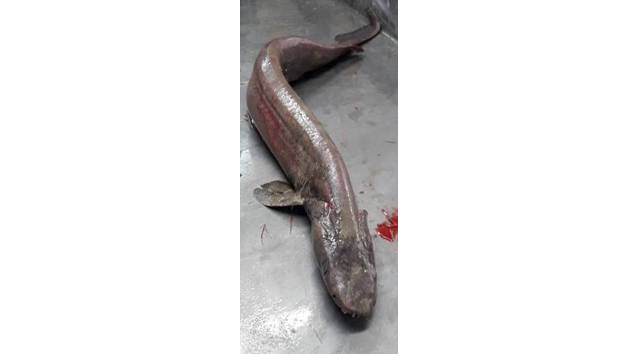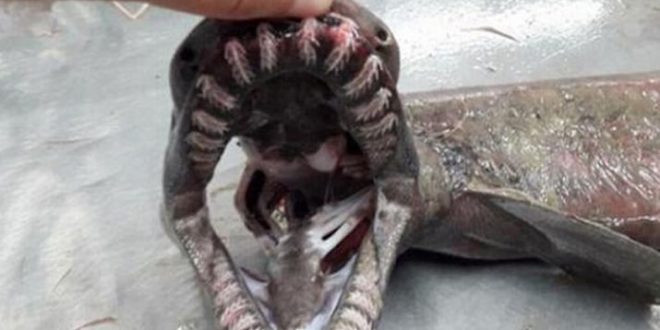A frilled shark (Chlamydoselachus anguineus), a species that is often termed a ‘living fossil’ because of several ‘primitive’ features that have survived for millions of years, has been captured off the coast of Portugal’s Algarve region, the country’s meteorological and sea institute has announced.
Chlamydoselachus anguineus, is found on continental shelves and the nearshore areas of large islands, although they are occasionally reported in open waters. They are mostly benthic and occur at depths from 100 to 1,300 meters.
Eel-like shark with 6 gill slits, terminal mouth with tricuspid teeth in both jaws, and one dorsal fin.
Body slender and eel-like, with prominent keels on abdomen. Head with 6 pairs of gill slits, the lower ends of the first gill slits connected to each other across throat; snout extremely short, truncated; mouth terminal on head, very long; teeth alike in upper and lower jaws, with three strong cusps and a pair of intermediate cusplets, not saw or bladelike, posterior teeth not minute and granular. Anal fin large, larger than dorsal fin; caudal fin without a subterminal notch.
This Portuguese shark was 1.5 meters (5 feet) but no word yet on whether it’s male or female.
Samuel Garman was one of the first scientists to study the animal, back in 1883. He believed its snake-like qualities inspired legends of sea serpents. Scientists today think it’s likely they attack their prey the same way snakes do, by striking suddenly. But because there is very little footage of the shark, we do not know for sure.
As the scientists point out to reporters at Sic Noticias, a Portuguese TV channel, there is “little known in terms of its biology or environment”. While these spooky-looking fish can be found in locations across the Pacific and Atlantic oceans, they have a patchy range and prefer deeper waters. This means there is very little video footage of the sharks in their natural habitat and they are very rarely caught. When they are, it’s even rarer for them to be taken back to the laboratory to be studied.

Agencies/Canadajournal
 Canada Journal – News of the World Articles and videos to bring you the biggest Canadian news stories from across the country every day
Canada Journal – News of the World Articles and videos to bring you the biggest Canadian news stories from across the country every day



